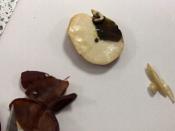Introduction Enzymes are catalytic molecules made up of proteins which speed up specific reactions. Such reactions occur when atoms or molecules come together and form new, more stable relationships. Enzymes are not permanently altered or used up in a reaction; they can be used over and over again. An enzyme is also highly selective of its substrates. Substrates are molecules that a specific enzyme can chemically recognize, bind, and modify in a specific way, which in this experiment, are the starch molecules(Starr, 1994).
The procees by which strarch is broken down is called starch hydrolysis. When this occurs, polysaccharide starch molecules are broken down into modified forms known as disacharides. This process is activated by the salivary enzyme within the mouth which catalyses polysacharides into maltose, a disaccharide. Maltose is then further broken down into simple sugars(glucose) by maltase, another enzyme.
These reactions however occur only under specific environental conditions provided within the mouth.
This experiment assesses at which pH level salivary amylase works best under, in the breakdown of starches, with the pH of 7 (average pH level found within the mouth) hypothesized to be more efficient in starch hydrolysis by salivary amylase.
Materials and Methods While waiting for the spectrophotometer to warm up at a wavelength of 560nm for at least 20 minutes, the following tasks were performed. A testtube rack was obtained containing 3 rows of 11 testtubes. Each of the 3 rows were labeled according to the pH levels of 5.0, 7.0, and 8.0. All 11 tubes in each row were then labeled in reference to seconds: 0, 30, 60, 90, 120, 150, 180, 210, 240, 270, and 300. A "blank tube"� was obtained and 3 mL of distilled water and 1 drop of potassium iodine was diluted into the tube.
The enzyme collected...


